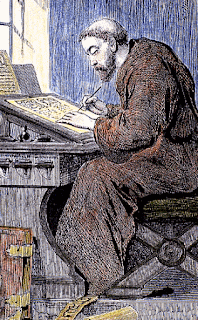A few years back I took an online course called Perspectives in World Missions...http://www.perspectives.org. It is an awesome course and I learned so much through it!
One very memorable article I read was entitled, The Kingdom Strikes Back by Ralph D. Winter. This is the seventh part of the article:
Under the particular circumstances of that time, similar to many chaotic corners of the world today, the most durable structure around was the order—a fellowship much more highly disciplined and tightly-knit than the usual American Protestant congregation today. Its “houses” came to dot the landscape of Europe. We must admit, furthermore, that these novel Christian communities not only were the source of spirituality and scholarship during the Middle Ages, but they also preserved the technologies of the Roman industrial world—tanning, dyeing, weaving, metalworking, masonry skills, bridge building, etc. Their civil, charitable and even scientific contribution is, in general, grossly underestimated—especially by Protestants who have developed unfriendly stereotypes about “monks.” Probably the greatest accomplishment of these disciplined Christian communities is seen in the simple fact that almost all our knowledge of the Roman world is derived from their libraries, whose silent testimony reveals the appreciation they had, even as Christians, for the “pagan” authors of ancient times.
Thus, in our secular age it is embarrassing to recognize that had it not been for these highly literate “mission field” Christians who preserved and copied manuscripts (not only of the Bible but of ancient Christian and non- Christian classics as well), we would know no more about the Roman Empire today than we do of the Mayan or Incan empires, or many other empires that have long since almost vanished from sight.
Many Evangelicals might be jolted by the Wheaton professor who wrote an appreciative chapter about these disciplined order structures entitled, “The Monastic Rescue of the Church.” One sentence stands out:
The rise of monasticism was, after Christ’s commission to his disciples, the most important—and in many ways the most beneficial—institutional event in the history of Christianity (p. 84).
Curiously, our phrase Third World comes from those days when Greek and Latin were the first two worlds and the barbarians to the north were the Third World. Using this phrase, Barbarian Europe was won more by the witness and labors of Celtic and Anglo- Saxon converts of the Celts—“Third World missionaries”—than by the efforts of missionaries deriving from Italy or Gaul. This fact was to bear decisively upon the apparently permanent shift of power in Western Europe from the Mediterranean to northern Europe. Even as late as AD 596, when Rome’s first missionary headed north (with serious faintheartedness), he incidentally crossed the path of the much more daring and widely-traveled Irish missionary, Columba, one of the scholarly Celtic peregrini who had worked his way practically to Rome’s doorstep and who was already further from his birthplace than Augustine was planning to go from his.
We are not surprised that Constantinople was considered the “Second Rome” by those living in the East, nor that both Aachen (in Charlemagne’s France) and Moscow were later to compete for recognition as new Romes by the descendants of the newly Christianized Franks and Slavs, respectively. Neither the original Rome as a city nor the Italian peninsula as a region were ever again to be politically as significant as the chief cities of the new nations— Spain, France, Germany, and England.



No comments:
Post a Comment